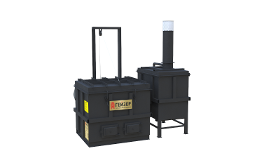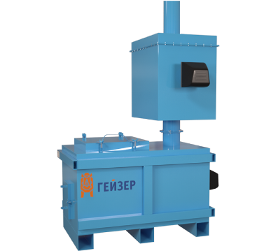- europages
- >
- COMPANIES - SUPPLIERS - SERVICE PROVIDERS
- >
- incinerators
Results for
Incinerators - Import export

EUROPEM
Belgium
Most of the Europem incinerators are equipped with waste heat recovery systems. Europem has supplied a wide range of waste heat recovery installations including steam boilers, thermal oil boilers, gas-liquid heat exchangers, gas-gas heat exchangers, bath heaters and air heaters. All waste heat recovery installations are tailored to the needs of the client and the optimal design of the overall installation. Our range of waste heat recovery systems include: -Fired tube boilers with or without economizer. Single pass and multi-pass systems can be supplied Boilers can be equipped with an on-line cleaning system to allow operation with dust-loaded (flue) gases Boilers up to 30 MW capacity can be supplied with pressures ranging from 10 to 22 bar. - Single pass and multi-pass systems can be supplied -Water tube boiler boilers with or without economizer Superheated or saturated steam Horizontal or vertical boiler arrangements Bundles in refractory lined casing or with membrane walls Capacities up to 40 MWth with pressures ranging from 15 to 65 bar. – Thermal oil boilers – Bath heat exchangers – Air – flue gas tube and shell heat exchangers – Flue gas – liquid tube and shell heat exchangers – Air heaters Heat exchangers can be manufactured in carbon steel or high grade alloys e.g. Duplex, Hasteloy, Inconel, AISI 316, AISI 304.
Request for a quote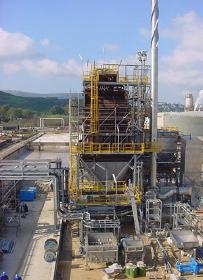
EUROPEM
Belgium
A fluidised bed incinerator is the technology of choice for the combustion of many sludge streams or solid waste streams with a high moisture content. In a fluidised bed reactor, an inert material, typically calibrated quartz sand, is fluidised by blowing air through the bed. The sand bed expands and provides an ideal medium for the mixing of waste with combustion air. Because the fluidised bed is maintained at an elevated temperature, typically between 650°C and 800°C the water evaporates and volatile organic compounds mix with combustion air whilst escaping from the fluidised bed. EUROPEM fluidised bed reactors are bubbling fluidised beds with high turbulence. Different feeding systems can be supplied ranging from feeding screws and over spreader stokers to injection lances. Key Features Turbulent bubbling fluidized bed of inert material Different feeding systems for solid waste, waste liquids and waste gases Can be operated in a reducing or oxidising environment Key Advantages - Robust and flexible design to burn sludge or solid waste with high moisture content – Stable combustion process of waste with varying moisture content over time – Proven technology – Destruction efficiency over 99.99% and less than 1% carbon in the ashes – Low NOx and CO emissions possible – Flue gas treatment train needed to meet acid, heavy metal, dust and PCDD/F emission levels
Request for a quote
EUROPEM
Belgium
Rotary kiln incinerators are the workhorse of industry to burn solid waste in combination with sludge, waste gas and/or waste liquids and where the rotating motion transports the solid burning waste through the incinerator. Ashes are collected at the end of the rotating kiln and then combustion gases are completely oxidised in the static post combustion chamber. Rotary kiln incinerators typically feature different types of solid waste feeding systems for the bulky solid waste, containers and drums such as feeding screws and ram feeders. Waste gases and liquids are either injected into the rotary kiln, or the (vertical) post combustion chamber behind the rotary kiln. It provides for flexible and versatile incineration technology, but is characterised by a lower thermal efficiency with the associated higher operating and maintenance costs. Key Features Rotary kiln furnace with pre-set inclination and variable rotation speed. Labyrinth type seal with cooling and/or flushing with inert gas Different feeding systems for solid waste, waste liquids and waste gases Can be operated in a reducing or oxidizing environment Different drive mechanisms such as chain or direct drive, depending on the size of the kiln and the capacity Key Advantages - Robust and flexible design to burn a wide range of waste fractions – Proven technology – Destruction efficiency over 99.999% and less than 3% carbon in the ashes – Low NOx and CO emissions possible – Flue gas treatment train needed to meet acid, heavy metal, dust and PCDD/F emission levels
Request for a quote
EUROPEM
Belgium
A SRU incinerator is an oxidation-reduction reactor for the recovery of elemental Sulphur from H2S rich waste gases. The first stage of the so called Claus process, is the complete free flame oxidisation of typically 1/3 of the H2S to SO2 in a reaction furnace (H2S + 1½ O SO2 + H2O). The SO2 and the then remaining H2S undergo the Claus reaction both in the reaction furnace and in a series of catalytic reactors (2 H2S + SO2 3S + 2 H2O) resulting in the overall chemical reaction H2S + ½ O H2 + S. Key Features One combustion chamber with mixing wall Part of the waste containing H2S is injected through the burner, the remainder before the mixing wall. The burner is a robust Multifuel design suitable for the combined combustion of different waste gas and gaseous or liquid support fuel streams. The mixing wall ensure the waste and combustion gases combine and also ensures a uniform temperature profile to improve the overall efficiency of the reaction. Key Advantages - Sulphur recovery – Ultra-low NOx combustion possible – Complete oxidisation of all hydrocarbons – No CO formation – Complete odour destruction – Destruction efficiency over 99.99% – For waste air/gas streams containing a high percentage of H2S
Request for a quote
EUROPEM
Belgium
A Redu-reox incinerator features three reaction chambers for the low NOx combustion of waste streams and fuels with a high organically bound Nitrogen content. In the first reaction chamber a reducing environment is maintained to ensure that any free Oxygen will react with Hydrogen to form water. No Oxygen is left to combine with Nitrogen to form NOx. Complete combustion is achieved in the re-oxidation chamber, after the gases have been cooled in the quench stage. The temperature in the re-oxidation chamber is below 950°C to ensure that any Oxygen reacts with Carbon and Hydrogen and not Nitrogen, to minimize formation of thermal NOx. Key Features Three reaction chambers with staged combustion and intermediate flue gas cooling. First chamber operating under a reducing atmosphere at a temperature above 1250oC. Second chamber to quench the flue gases to about 800°C by either injection of steam or recirculated flue gas. Third or re-oxidation chamber for the post-combustion of remaining waste components at temperatures above 900oC. Key Advantages - Ultra-low NOx combustion of waste streams with high bound Nitrogen contents. – Complete oxidation with all hydrocarbons destroyed – No CO formation – Complete odour destruction – No need for SNCR or SCR deNOx to meet emission limits – Destruction efficiency over 99.999%
Request for a quote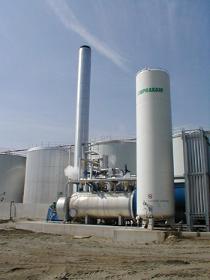
EUROPEM
Belgium
The HI Incinerator features a combustion chamber with a mixing wall which divides this chamber into a high temperature combustion HI zone and a lower temperature post-combustion zone. This particular configuration is most suited to the fuel efficient combustion of lean waste gases and effluents, as it reduces the need for any support fuel. Key Features - Combustion chamber with mixing wall – High intensity combustion zone at elevated temperatures – Waste gases and liquids are delivered to the HI zone through the burner and a series of injection lances. – The mixing wall creates a high temperature zone around flame ensuring complete oxidisation and also to increase turbulence, thus avoiding cold spots and the formation of CO – Post-combustion zone after the mixing wall to ensure residence time of 2 seconds at >850°C Key Advantages - All hydrocarbons are destroyed – No CO formation – Complete odour destruction – Up to 20% fuel saving – Destruction efficiency over 99.99%
Request for a quote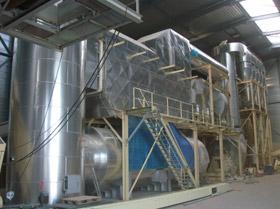
EUROPEM
Belgium
A LedeNOx incinerator is an oxidisation-reduction reactor and is the ideal design to achieve low NOx emissions whilst burning waste streams that contain Ammonia and bound Nitrogen. Part of the waste stream containing Ammonia is oxidised and forms NOx in the process. This NOx is then reduced by injecting the remaining Ammonia rich waste stream, where the Ammonia is used to promote a non-catalytic deNOx reaction and reduce NOx to Nitrogen and water. Key Features One combustion chamber with two mixing walls Part of the Ammonia containing waste is injected through the burner, part between the mixing walls. Part of the Ammonia is oxidised to form NOx, whilst the remaining Ammonia is used to react with NOx to form N2. The mixing walls ensure that the waste and combustion gases are mixed and also ensures a uniform temperature profile to improve the overall efficiency of the deNOx reaction. Key Advantages No need for SNCR or SCR deNOx to meet emission limits Ultra-low NOx combustion of waste streams with high bound Nitrogen or Ammonia contents. Complete oxidisation and destruction of all hydrocarbons No CO formation Complete odour destruction Destruction efficiency over 99.999%
Request for a quote
INCINER8 LIMITED
United Kingdom
Our flagship medical incineration unit, suitable for high volumes of waste and is the perfect power plant for any of our waste to energy solutions. Featuring award winning innovations and an exceptional build quality, this is an incinerator that will last for years to come.
Request for a quote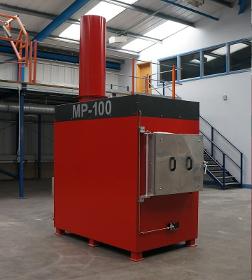
ADDFIELD ENVIRONMENTAL SYSTEMS
United Kingdom
The MP-100 is a very productive small compact medical incineration unit. The machine is extensively used around the world and is ideal for Hospitals, Primary Medical Services, Research Centres, Pharmaceutical Manufacturers, Private Surgery Practices, Cosmetic Surgery Practices, Care Homes, Tattoo Surgeries and other Clinical Waste facilities. The MP-100 machine is equipped with a 0.4m³ chamber and Hot hearth technology. Hot hearth technology effectively incinerates waste from above and below simultaneously. As such whilst the MP-100 machine can handle a wide variety of waste, it is especially competent when dealing with Category 2, 3 and 4 types or those less than <3000Kcal or red bag waste.
Request for a quote
ADDFIELD ENVIRONMENTAL SYSTEMS
United Kingdom
With a loading chamber of up to 250kg, the Mini AB is the smallest of the agricultural / Animal Bi-product incinerators, making the unit ideal for poultry waste, with on average 75 chickens per batch load to be incinerated. The Mini AB is also an ideal machine for the Kennel and Cattery sector, it is very durable and easy to use. Waste is top loaded through a counter weight lid. Reduction of waste to 3% of ash.
Request for a quote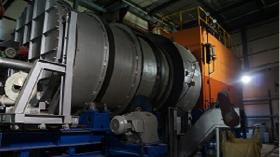
EC PLAZA
South Korea
To build a continuous supply steam supply system of 24 hours to reduce the existing energy cost in power generation, is a business-friendly environment to meet the low-carbon green growth national policy Product Specification 100Kw~3,000KW/H Product Use Used for waste incineration power generation system and wood pellet (coal) power generation system Our Company Changhwaenergy co.,ltd. The technology of CHANGHWA ENERGY is developed with utmost effort to create eco-friendly technology for the times of low-carbon era. Our accumulated technology has been a source of new leaps and we have achieved higher customer satisfaction than ever before. As a result of excellent technology development and research, we have developed and manufactured eco-friendly multi-tube electric boiler and constructed the production system.
Request for a quote
ENNOX BIOGAS TECHNOLOGY GMBH
Austria
Every year, millions of tons of household garbage and other refuse are deposited in landfills around the world. Bio-chemical decomposition processes of organic bonds in these landfills produce up to 150 - 250 m of landfill gases per tonne of household garbage. Due to a methane content of up to 60%, landfill gas ranks number six on the list of climate-disrupting methane producers worldwide, but it is also an important source of energy with enormous potential if used sensibly. Up to a content level of approximately 40% methane, landfill gas may still be recovered usefully in modern block heating plants. The important factor in this case is an effective and project-specific pre-cleaning process for the gas. We can help by providing you various gas cleaning systems, gas drying systems, and activated carbon filters, and pressure increasing stations. The components may be used as individual models or delivered as a complete system that is built into a container. Landfill gas...

EBINGER KATALYSATORSERVICE GMBH & CO. KG
Germany
There is a typical case of application for successfully cleaning DeNOx -catalysts in the DeNOx-plant which does not require any complex dismantling and reassembling: The removal of ammonium salt from the surface of DeNOx-catalysts in incineration plants. Here, we have several years of experience in restoring activity from 90 up to 100 %. Besides the cost saving, this procedure has enormous logistical advantages as shorter shutdowns can also be used. Comprising a catalyst volume of up to 50 cubic metres simply requires three to five days which includes the building site installation. During the “Wildeshauser Catalyst Days” in September 2008, incineration plant owners reported their experiences with our in-situ-cleaning, in detail.
Request for a quote
AKROMAK METAL DIŞ TIC. LTD. ŞTI.
Turkey
Paddle, 2-parts, machined, 140 mm wide, Paddel, material: heat resistant steel casting 1.4848 / GX40CrNiSi25-20 or 2.4879 / G-NiCr28W
Request for a quote
AKROMAK METAL DIŞ TIC. LTD. ŞTI.
Turkey
Pusher plate, as cast, 300 mm wide, without air outlet slots, material: material: heat resistant steel casting 1.4823 GX40CrNiSi27-4
Request for a quote
AKROMAK METAL DIŞ TIC. LTD. ŞTI.
Turkey
Pusher plate, as cast, 120 mm wide, without air outlet slots, material: material: heat resistant steel casting 1.4823 GX40CrNiSi27-4
Request for a quote
AKROMAK METAL DIŞ TIC. LTD. ŞTI.
Turkey
Air cooled roller grate bar, as cast, 90 mm wide, Roststab, without air outlet slots, material: iron casting GG-20 / EN-GJL-200
Request for a quoteDo you sell or make similar products?
Sign up to europages and have your products listed

AKROMAK METAL DIŞ TIC. LTD. ŞTI.
Turkey
Air cooled grate bar, as cast, 80 mm wide, Roststab, without air outlet slots, material: heat resistant steel casting 1.4823 GX40CrNiSi27-4
Request for a quote
AKROMAK METAL DIŞ TIC. LTD. ŞTI.
Turkey
Air cooled grate bar, as cast, 99,2 mm wide, Roststab, with air outlet slots, material: heat resistant steel casting 1.4777 GX130CrSi29
Request for a quote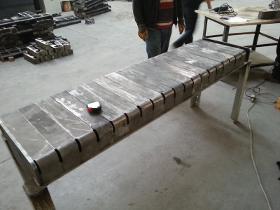
AKROMAK METAL DIŞ TIC. LTD. ŞTI.
Turkey
Air cooled grate bar, machined, 100 mm wide, Roststab, with air outlet slots, material: heat resistant steel casting 1.4823 GX40CrNiSi27-4
Request for a quote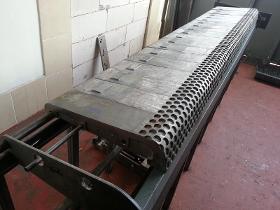
AKROMAK METAL DIŞ TIC. LTD. ŞTI.
Turkey
Air cooled grate bar, machined, 132,5 and 137,5 mm wide, Roststab, without air outlet slots, material: heat resistant steel casting 1.4823 GX40CrNiSi27-4
Request for a quote
AKROMAK METAL DIŞ TIC. LTD. ŞTI.
Turkey
Air cooled grate bar, machined, 100 mm wide, Roststab, with air outlet slots, material: heat resistant steel casting 1.4823 GX40CrNiSi27-4
Request for a quote
AKROMAK METAL DIŞ TIC. LTD. ŞTI.
Turkey
Air cooled grate bar, machined, 200 mm wide, Roststab, with air outlet slots, material: heat resistant steel casting 1.4823 GX40CrNiSi27-4
Request for a quote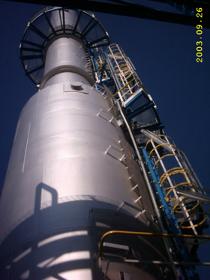
EUROPEM
Belgium
Normal incinerators for waste gas and/or waste liquids are used to destroy the hazardous waste streams with an efficiency higher than 99.99% whilst maintaining low NOx, CO and TOC emissions. Each incinerator is designed to meet project specific requirements, using standard modules and concepts. Vertical incinerators are mostly used where high dust formation e.g. ash or salt, are present. Most liquid and waste gas incinerators are horizontally configured. Key Features - Horizontal or vertical arrangement – Executed with or without mixing wall – Custom burner arrangements with separate waste gas or waste liquid injection lances, in the incinerator front wall, roof or body. – Designed to maintain a minimum residence time, typically one or two seconds, at a minimum temperature, typically 850°C or 1150°C depending on local legal requirements. Key Advantages - Destruction efficiency over 99.99% – Production of clean flue gases at high temperatures, as input for waste heat recovery units – No CO formation and low NOx emissions – Complete odour destruction
Request for a quote
GEYZER (KZKO LLC)
Russia
Incineration provides the highest destruction efficiency of waste. Slufer components and dangerous hydrocarbons from oil and gas industry, including BTEX can be incinerated, too. Our high technology constructions can achieve an efficiency of 99.9 %(DRF), depending on the materials you put in. Because of our know-how, we have automated the burning process to an optimal level with cost-economical fuel consumption. There are two kinds of incinerators: Hearth furnaces and rotary kiln. Booth are applicable in the oil and gas industry. Because of the higher sizes and quantity of disposal we recommend you to not smaller than IU-300. The best solution is IU-2000M due to its mobility and fast construction time.
Request for a quoteResults for
Incinerators - Import exportNumber of results
53 ProductsCountries
Category
- Waste and refuse incineration - plants (25)
- Casting, steel (11)
- Processing and recycling of waste (9)
- Animal feeding equipment (6)
- Medical Equipment (5)
- Industrial waste management (3)
- Hydraulic equipment (2)
- Refuse handling - machines and systems (2)
- Chemical catalysts (1)
- Energy - production plants and equipment (1)
- Oils, industrial (1)
- Plants and herbs, medicinal (1)
- Waste treatment and recycling - machines and installations (1)


